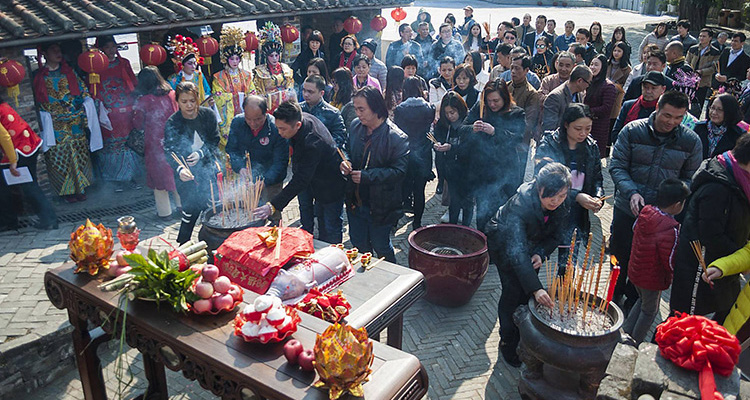Beijing Ancestor Worship: A Spiritual Journey
In the soft swirl of incense smoke, rituals from centuries ago still continue, as if a window to the past has quietly opened.
Walking through Beijing’s ancient hutongs, you might see a family placing willow branches above their doorway, or stand inside the grand Imperial Ancestral Temple and wonder why ancient emperors performed such solemn rites.
All of these moments lead back to one enduring tradition — Beijing ancestor worship — a living practice that connects generations through remembrance and gratitude.
For travelers, witnessing this ceremony offers more than a glimpse of Chinese culture. It’s a spiritual heritage experience, a quiet journey through history and family devotion that defines the heart of Chinese identity.
1. What Is Beijing Ancestor Worship? — A Family Dialogue Across Time
Beijing ancestor worship is often called a “conversation between the living and their forebears.” It’s a traditional ceremony expressing deep respect and gratitude toward one’s ancestors.
Imagine entering a tranquil room filled with sandalwood fragrance. Before ancestral tablets, family members line up by seniority, offering food, wine, and bows of reverence. It’s not a moment of sorrow but a warm family reunion — a bridge connecting past and present.
The soft glow of candles lights the offerings, and every move is done with calm precision. In that stillness, you can feel the quiet dignity of the ritual, one that invites silence and reflection. This ancestral veneration embodies values of respect, remembrance, and continuity.

2. The Story Behind the Tradition — A Living Fossil of Chinese Rituals
Ancestor worship in China dates back thousands of years. As Beijing served as the capital of the Yuan, Ming, and Qing dynasties, its practices evolved into a rich blend of Han, Manchu, and Mongol traditions — forming a unique Beijing ritual culture.
The layout of “Left Ancestral, Right Sheji” in the imperial city reflected the sacred importance of ancestor worship. On the left stood the Imperial Ancestral Temple, where emperors honored their lineage; on the right, the Altar of Earth and Grain, where they prayed for harvests.
While emperors held grand ceremonies, ordinary citizens performed family rituals at home or in clan temples. At the heart of all these traditions lies the Confucian value of — to remember one’s ancestors and preserve the bond of family lineage.
Through ancestral worship, Chinese people express loyalty to their roots, honor family values, and strengthen connections across generations — a principle still cherished today.

3. Experiencing the Ritual — A Cultural and Spiritual Offering
Ancestor worship in Beijing takes many forms, depending on family customs and ethnic heritage.
Where It Happens:
Some families visit ancestral graves in the countryside; others pray at home before ancestral tablets in the main hall.
Offerings and Symbols:
Han families prepare bowls of meat and fish; southern families often arrange eight dishes with a hotpot centerpiece; Manchu families offer pastries, apples, and incense cakes. Every item carries meaning — abundance, harmony, or continuity.
Paper Offerings:
Even paper money used in rituals is made with great care — high-quality xuan paper ensures smooth burning, and golden pigment is mixed carefully for symbolic purity.
Time of Worship:
Traditional Beijing families often hold ceremonies on Lunar New Year’s Eve and conclude them after the Lantern Festival. During this time, visitors offering New Year greetings must also bow before the ancestral shrine — showing how deeply ancestor veneration shapes local customs.

4. How Visitors Can Respectfully Experience It
For foreign travelers, Beijing offers many ways to observe or learn about Chinese ancestral rites:
Observation Tips:
- Watch the sequence of incense offering and bowing by seniority.
- Notice how offerings are arranged — their placement carries symbolic meaning.
- Participants dress modestly, in black, gray, or white tones.
- The overall atmosphere — incense, candles, and quiet gestures — creates solemn beauty.
Participatory Experiences:
- During Qingming Festival, visit Changping’s Yanhuang Mausoleum, where families honor ancestors with flowers instead of paper offerings — a “green” form of remembrance.
- Join local cultural tourism programs like the Central Axis Ritual Walk, where you can learn about Beijing’s royal and folk rituals through immersive storytelling.
- Always stay respectful: don’t interrupt, take intrusive photos, or make jokes during ceremonies. Quiet observation is the best way to appreciate this living tradition.

5. Where to Discover the Tradition — Sites of Living Heritage
Historic Sites:
- Imperial Ancestral Temple (Taimiao): Once used by Ming and Qing emperors for royal ancestral rites, now a serene cultural park.
- Temple of Heaven: A sacred site for worshiping Heaven, larger than the Forbidden City, symbolizing ancient cosmic order.
- Temple of Agriculture (Xiannongtan): The most complete surviving altar for imperial agricultural rituals, now hosting cultural exhibitions.
Modern Cultural Experiences:
- During Qingming, stroll through old hutongs to see traditional customs like hanging willow branches at doors — symbols of renewal and remembrance.
- Visit the Beijing Ancient Architecture Museum, located in Xiannongtan, to learn about ancient ritual buildings and their meanings.

Travel Tips:
- Best times: Qingming Festival (April) or Chinese New Year (January–February)
- Dress modestly and maintain a quiet, respectful attitude
- Bring curiosity and reflection — as you stand on the Circular Mound of the Temple of Heaven or glimpse willow branches swaying in a hutong breeze, you’ll feel that Beijing ancestor worship is not just a ceremony, but a timeless dialogue between generations.


